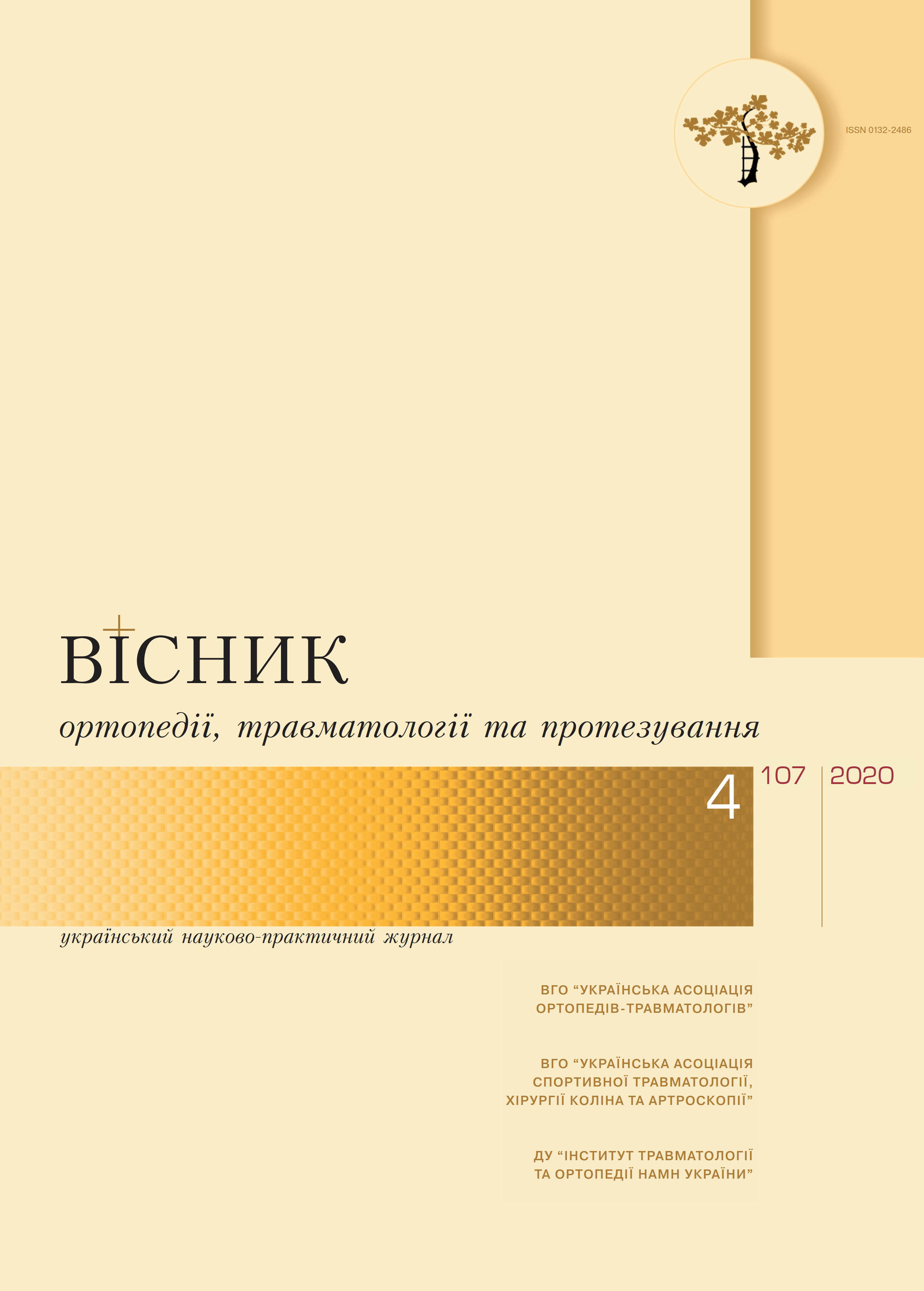Abstract
Summary. Partial tear of the pectoralis major muscle (PMM) is an extremely rare injury, but it needs to be studied.
Objective: to carry out a comparative analysis of the clinic, diagnosis and treatment of patients with complete and partial tears of the PMM.
Materials and Methods. A retrospective analysis of 9 patients with partial tears of the PMM who underwent surgical and conservative treatment at the Department of Microsurgery and Reconstructive Surgery of Upper Extremity of the SI “Institute of Traumatology and Orthopedics of NAMS of Ukraine” (Kyiv) from 2008 to 2018 was performed. The mean age of patients with partial tear of the PMM was 37.4±10.8 years (16 to 42 years); 8 were males and 1 was female. The follow-up period after surgical or conservative treatment was 12±2.8 months. The greatest number of injuries occurred during the bench press exercises – 55.6% (5 patients); on the uneven bars – 22.2% (2 patients) and in everyday life – 22.2% (2 patients).
Results. Follow-up examination revealed that 55.6% (5 patients) had injuries of tendon-muscle transition IIC, 33.3% (3 patients) – of tendon part II D, and 11.1% (1 patient) – of muscle II B according to the Cordasco 2020 classification. All the patients deny taking steroids to increase muscle mass. Surgical treatment was performed within 10-643 days after the injury. Two operated on patients had acute injuries (up to 8 weeks after the trauma), and 3 had chronic injuries (more than 8 weeks after the trauma). The results on both the Quick DASH scale and the Subjective Evaluation of Patients with Pectoralis Major Muscle Injuries Questionnaire were negative in both groups during initial treatment. One year after the treatment, excellent and good results were observed in the operated on group; the conservative group showed unsatisfactory results. We did not note any complications after surgical interventions in operated on group of patients.
Conclusions. Partial tears of the PMM require more careful differentiation and additional examination methods. Physically active patients with isolated tears of the PMM need surgical treatment. Such treatment gives excellent and good results, while conservative treatment – unsatisfactory. Due to the small number of patients in our study, partial PMM tears require further investigation.
References
Marsh NA, Calcei JG, Antosh IJ, Cordasco FA. Isolated tears of the sternocostal head of the pectoralis major muscle: surgical technique, clinical outcomes, and a modification of the Tietjen and Bak classification. J Shoulder Elbow Surg. 2020;29(7):1359-67. DOI: 10.1016/j.jse.2019.11.024.
Haley CA, Zacchilli MA. Pectoralis major injuries: evaluation and treatment. ClinSports Med. 2014;33(4):739-56. DOI: 10.1016/j.csm.2014.06.005.
FungL, Wong B, Ravichandiran K, Agur A, Rindlisbacher T, Elmaraghy A. Three-dimensional study of pectoralis major muscle and tendon architecture. Clin Anat. 2009;22(4):500-8. DOI: 10.1002/ca.20784.
ElMaraghy AW, Rehsia SS, Pennings AL. Utility of the pectoralis major index in the diagnosis of structurally significant pectoralis major tears. Orthop J Sports Med. 2013;1(7):1-7. DOI: 10.1177/2325967113516729.
Kakwani RG, Matthews JJ, Kumar KM, Pimpalnerkar A, Mohtadi N. Rupture of the pectoralis major muscle: Surgical treatment in athletes. Int Orthop. 2007;31(2):159-163. DOI: 10.1007/s00264-006-0171-2
Elliot BC, Wilson GJ, Kerr GK. A biomechanical analysis of the sticking region in the bench press. Med Sci Sports Exerc. 1989;21(4):450-62. PMID: 2779404.
Wolfe SW, Wickiewicz TL, Cavanaugh JT. Ruptures of the pectoralis major muscle. An anatomic and clinical. Am J Sports Med Sep. 1992;20(5):587-93. DOI: 10.1177/036354659202000517.
Chang ES, Zou J, Costello JM, Lin A. Accuracy of magnetic resonance imaging in predicting the intraoperative tear characteristics of pectoralis major ruptures. J Shoulder Elbow Surg. 2016;25(3):463-8. DOI: 10.1016/j.jse.2015.08.037.
Bak K, Cameron EA, Henderson IJ. Rupture of the pectoralis major: a meta-analysis of 11 cases. Knee Surg Sports Traumatol Arthrosc. 2000;8(2):113-9. DOI: 10.1007/s001670050197.
Hanna CM, Glenny AB, Stanley SN, Caughey MA. Pectoralis major tears: comparison of surgical and conservative treatment. Br J Sports Med. 2001;35(3):202-206. DOI: 10.1136/bjsm.35.3.20.
Schepsis AA, Grafe MW, Jones HP, Lemos MJ. Rupture of the pectoralis major muscle. Outcome after repair of acute and chronic injuries. Am J Sports Med. 2000;28(1):9-15. PMID: 10653537. DOI: 10.1177/03635465000280012701.
ElMaraghy AW, Devereaux MW. A systematic review and comprehensive classification of pectoralis major tears. J Shoulder Elbow Surg 2012;21(3):412-22. DOI: 10.1016/j.jse.2011.04.035.
de Castro Pochini A, Andreoli CV, Belangero PS, Figueiredo EA, Terra BB. Clinical considerations for the surgical treatment of pectoralis major muscle ruptures based on 60 cases: a prospective study and literature review. Am J Sports Med 2014;42(1):95-102. DOI: 10.1177/0363546513506556.
Godoy IRB, Martinez-Salazar EL, Simeone FJ, Bredella MA, Palmer WE, Torriani M. MRI of pectoralis major tears: association between ancillary findings and tear severity. Skeletal Radiol. 2018;47(8):1127-35. DOI: 10.1007/s00256-018-2893-9.
Chiavaras MM, Jacobson JA, Smith J, Dahm DL. Pectoralis major tears: anatomy, classification, and diagnosis with ultrasound and MR imaging. Skeletal Radiol 2015 Feb;44(2):157-64. DOI: 10.1007/s00256-014-1990-7.
Shepard NP, Westrick RB, Owens BD, Johnson MR. Bony avulsion injury of the pectoralis major in a 19 year-old male judo athlete: a case report. Int J Sports Phys Ther. 2013 Dec;8(6):862-70. PMCID: PMC3867079, PMID: 24377072.
Страфун С.С, Куринной И.Н., Безуглый А.А., Черенок П.Е., Хименко А.С. Хирургия сухожилий пальцев кисти. Киев: Макрос; 2012. С.70

This work is licensed under a Creative Commons Attribution 4.0 International License.

